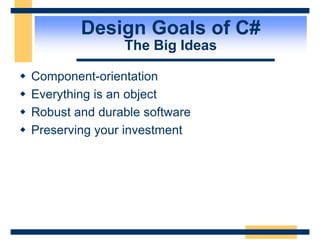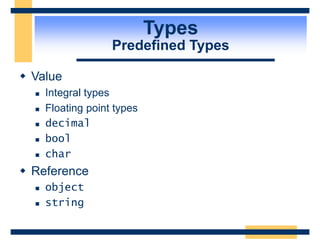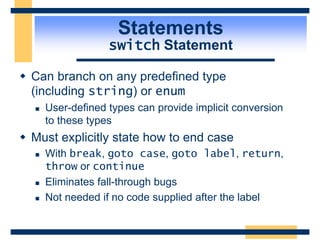This document provides an introduction to the C# programming language. It outlines prerequisites, learning objectives, and an agenda. The agenda includes an overview of C#'s design goals like component orientation and everything being an object. It also covers C# fundamentals like types, program structure, statements, operators, and using Visual Studio.NET and the .NET framework. Types discussed include value types like integral and floating point numbers as well as reference types like strings and objects.

















![Types
Unified Type System
Value types
Primitives int i; float x;
Enums enum State { Off, On }
Structs struct Point {int x,y;}
Reference types
Root object
String string
Classes class Foo: Bar, IFoo {...}
Interfaces interface IFoo: IBar {...}
Arrays string[] a = new string[10];
Delegates delegate void Empty();](https://image.slidesharecdn.com/introductiontocsharp-221212072134-95e37f67/85/IntroductionToCSharp-ppt-18-320.jpg)




























![Types
User-defined Types
User-defined types
Enumerations enum
Arrays int[], string[]
Interface interface
Reference type class
Value type struct
Function pointer delegate](https://image.slidesharecdn.com/introductiontocsharp-221212072134-95e37f67/85/IntroductionToCSharp-ppt-47-320.jpg)




![Types
Arrays
Declare
Allocate
Initialize
Access and assign
Enumerate
int[] primes;
int[] primes = new int[9];
int[] prime = new int[] {1,2,3,5,7,11,13,17,19};
int[] prime = {1,2,3,5,7,11,13,17,19};
prime2[i] = prime[i];
foreach (int i in prime) Console.WriteLine(i);](https://image.slidesharecdn.com/introductiontocsharp-221212072134-95e37f67/85/IntroductionToCSharp-ppt-52-320.jpg)
![Types
Arrays
Multidimensional arrays
Rectangular
int[,] matR = new int[2,3];
Can initialize declaratively
int[,] matR =
new int[2,3] { {1,2,3}, {4,5,6} };
Jagged
An array of arrays
int[][] matJ = new int[2][];
Must initialize procedurally](https://image.slidesharecdn.com/introductiontocsharp-221212072134-95e37f67/85/IntroductionToCSharp-ppt-53-320.jpg)


















![Program Structure
Main Method
Execution begins at the static Main() method
Can have only one method with one of
the following signatures in an assembly
static void Main()
static int Main()
static void Main(string[] args)
static int Main(string[] args)](https://image.slidesharecdn.com/introductiontocsharp-221212072134-95e37f67/85/IntroductionToCSharp-ppt-72-320.jpg)











![Statements
Labeled Statements & goto
goto can be used to transfer control within or
out of a block, but not into a nested block
static void Find(int value, int[,] values,
out int row, out int col) {
int i, j;
for (i = 0; i < values.GetLength(0); i++)
for (j = 0; j < values.GetLength(1); j++)
if (values[i, j] == value) goto found;
throw new InvalidOperationException(“Not found");
found:
row = i; col = j;
}](https://image.slidesharecdn.com/introductiontocsharp-221212072134-95e37f67/85/IntroductionToCSharp-ppt-84-320.jpg)






![Statements
foreach Statement
Iteration of arrays
public static void Main(string[] args) {
foreach (string s in args)
Console.WriteLine(s);
}](https://image.slidesharecdn.com/introductiontocsharp-221212072134-95e37f67/85/IntroductionToCSharp-ppt-91-320.jpg)

![Statements
Jump Statements
break
Exit inner-most loop
continue
End iteration of inner-most loop
goto <label>
Transfer execution to label statement
return [<expression>]
Exit a method
throw
See exception handling](https://image.slidesharecdn.com/introductiontocsharp-221212072134-95e37f67/85/IntroductionToCSharp-ppt-93-320.jpg)













![Operators
Precedence
Category Operators
Primary
Grouping: (x)
Member access: x.y
Method call: f(x)
Indexing: a[x]
Post-increment: x++
Post-decrement: x—
Constructor call: new
Type retrieval: typeof
Arithmetic check on: checked
Arithmetic check off: unchecked](https://image.slidesharecdn.com/introductiontocsharp-221212072134-95e37f67/85/IntroductionToCSharp-ppt-107-320.jpg)











